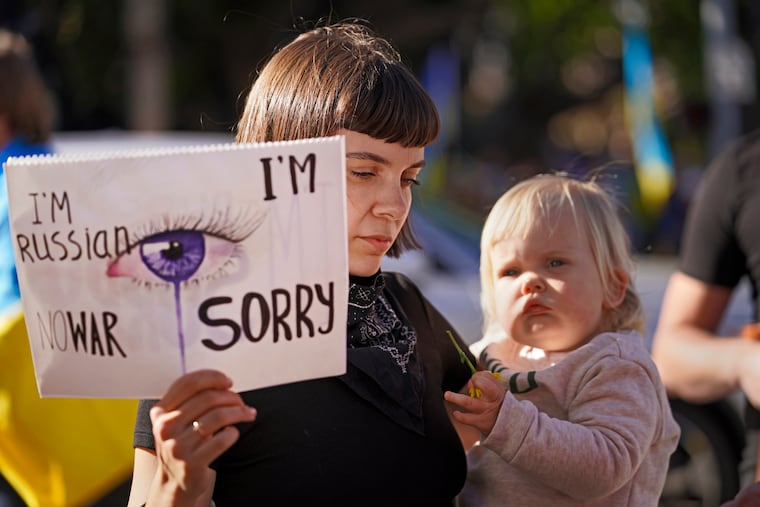How Ukrainians have used social media to humiliate the Russians and rally the world
A flood of real-time videos across Facebook, Telegram, TikTok and Twitter has blunted Kremlin propaganda and rallied the world to Ukraine's side.

Ukrainians and their supporters have used social media to bruise, belittle and humiliate the Russians, seeking to boost citizens’ spirits and sap invaders’ morale during the most Internet-accessible war in history.
A flood of real-time videos across Facebook, Telegram, TikTok and Twitter has blunted Kremlin propaganda and rallied the world to Ukraine's side as it fights to defend its democracy from a military behemoth.
It has also potentially saved lives: Ukrainians have raced to disseminate defensive strategies, plot escape routes, and document the brutality of a raging clash. Some expect that the phone footage recorded in recent days could play a critical role in investigating war crimes after the combat ends.
Russia has long been fabled as the Internet's most wily mischief-maker, and the nation's propaganda machine has for years used social and state-backed media to deceive and disempower its enemies.
But Ukraine has in many ways begun to beat Russia at its own game, using constant, colorful communication to foment a digital resistance and expose its aggression on a global stage.
The tactics reveal how social media has opened a new dimension of modern war, showing how the Internet has become not only a territory to fight over but a tactic for real-world conquest.
It has also helped Ukrainians believe that they can contribute to the fight. Solomiia Shalaiska, a Kyiv-based motion designer, said she felt helpless until she started posting pro-Ukraine rally images on an Instagram page she previously used for art and design.
One image — a David-and-Goliath-style map of both countries titled “Realize the Scale of Ukrainian Heroism” — has been “liked” more than 100,000 times in the last day. Shalaiska said she has joined the nation’s nascent “IT army” of volunteer hackers and hell-raisers, who have worked to counter Russian psychological operations by overwhelming their websites and flooding their intelligence officers with spam. (Shalaiska said she has helped mostly by spreading information and reporting bots.)
“It’s very important to [strengthen] the national spirit in Ukraine; that’s why people are doing memes and encouraging images,” she said in an Instagram message. People “should have sources where they can find not only Russian propaganda.”
The videos helped mobilize antiwar sentiment in the earliest hours of the invasion, when a woman was recorded admonishing Russian soldiers to carry seeds "so at least sunflowers will grow here when you die." In another Facebook photo, a funeral wreath with Russian President Vladimir Putin's name on it was captioned: "In Ukraine, the Russian army is greeted with flowers."
In the days since, videos have helped transform local stories of bravery into viral legends — and exposed a war Russia has fought to keep concealed. Ukrainians have posted videos of themselves thwarting tanks, guarding villages, making Molotov cocktails and using them to turn Russian vehicles into fireballs.
As Russia’s troubled blitz has smashed against a defiant resistance, some Ukrainian fighters have tactically trolled the enemy. In one video, a camouflaged soldier talks into the camera at his Russian opponents while screwing a silencer onto a rifle. “We have tanks. We’ve got everything,” he says with a smirk. “... Why don’t you ... surrender while you still have the chance.”
Ukrainians have also used social media to spur on fellow civilian defenders. Kira Rudik, a member of Parliament, posted a photo of herself barefoot and holding a Kalashnikov rifle to Instagram and Twitter, saying, “Our #women will protect our soil the same way as our #men.”
The posts have highlighted Russia's most embarrassing tactical and logistical errors, puncturing the nation's carefully crafted image of military supremacy with videos of grungy vehicles and an inexperienced fighting force.
In one video, a Ukrainian man ridicules Russian soldiers stranded after their tank ran out of fuel. In another, a tractor driver appears to tow a Russian armored personnel carrier down the road.
Other posts have become potent tools for strategy and intimidation, helping Ukrainians share videos and intelligence about the code signs of Russian saboteurs, the charred husks of Russian military vehicles, and the looted bodies of dead enemy troops.
Ukrainians have also shared online tactical guides on how to dodge sniper fire, block roadways and make explosive Molotov cocktails, sometimes alongside memes saying the Russians will find them “very delicious.”
When John Spencer, head of urban warfare studies at the U.S. Military Academy's Modern War Institute, on Saturday tweeted a guide for how "civilian resistors" could strike fear in the hearts of attacking Russians, Ukrainian users translated it almost immediately, sharing it across Telegram and making digital fliers.
Spencer, a 25-year military veteran who said the tweet has been viewed more than 10 million times, said he'd been inspired by photos of Ukrainian grandmothers volunteering to take up arms.
"This is kind of the new way of warfare," he said. "There's no more going away to war. We're all with Ukraine right now."